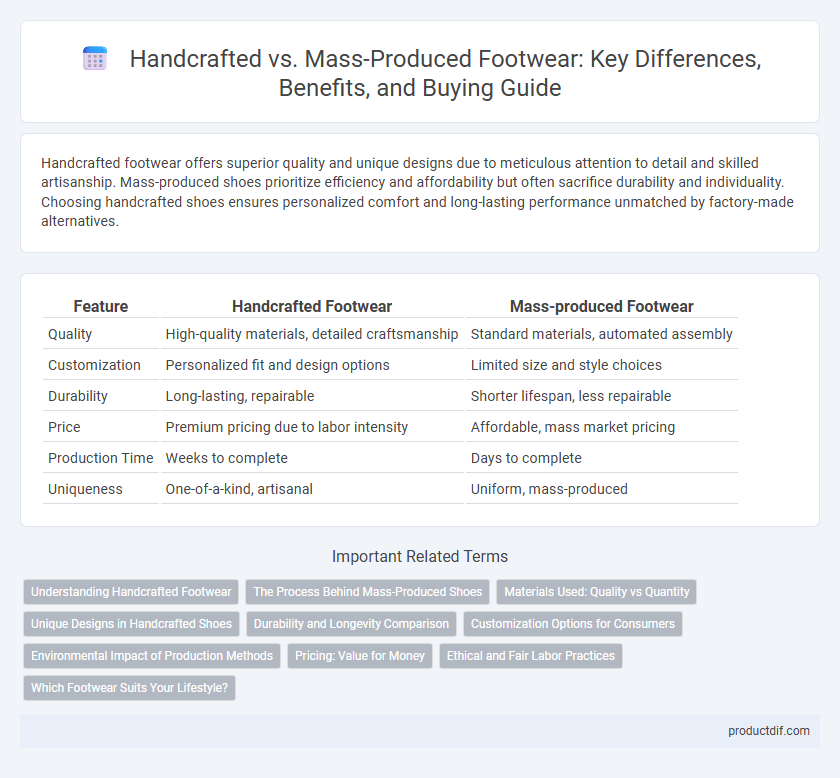Handcrafted footwear offers superior quality and unique designs due to meticulous attention to detail and skilled artisanship. Mass-produced shoes prioritize efficiency and affordability but often sacrifice durability and individuality. Choosing handcrafted shoes ensures personalized comfort and long-lasting performance unmatched by factory-made alternatives.
Table of Comparison
| Feature | Handcrafted Footwear | Mass-produced Footwear |
|---|---|---|
| Quality | High-quality materials, detailed craftsmanship | Standard materials, automated assembly |
| Customization | Personalized fit and design options | Limited size and style choices |
| Durability | Long-lasting, repairable | Shorter lifespan, less repairable |
| Price | Premium pricing due to labor intensity | Affordable, mass market pricing |
| Production Time | Weeks to complete | Days to complete |
| Uniqueness | One-of-a-kind, artisanal | Uniform, mass-produced |
Understanding Handcrafted Footwear
Handcrafted footwear is meticulously created by skilled artisans, ensuring superior quality, durability, and unique design details that mass-produced shoes often lack. Each pair undergoes precise hand-stitching and custom fitting processes, enhancing comfort and longevity. This craftsmanship results in exclusive, high-value footwear tailored for discerning customers seeking authenticity and personalized style.
The Process Behind Mass-Produced Shoes
Mass-produced shoes rely on automated machinery and assembly lines to achieve high-volume output with consistent quality. The process involves standardized molds, synthetic materials, and rapid stitching techniques designed to minimize production time and cost. This industrial approach contrasts with the intricate craftsmanship and personalized detailing found in handcrafted footwear.
Materials Used: Quality vs Quantity
Handcrafted footwear utilizes premium, carefully selected materials such as full-grain leather and natural rubber, ensuring durability and comfort. Mass-produced shoes often rely on synthetic materials and lower-grade components to meet large-scale demand and reduce costs. The emphasis on quality materials in handcrafted shoes results in longer-lasting performance compared to the quantity-driven approach of mass production.
Unique Designs in Handcrafted Shoes
Handcrafted shoes showcase unique designs that reflect the artisan's creativity and attention to detail, resulting in one-of-a-kind footwear with intricate patterns and personalized touches. Mass-produced shoes often prioritize uniformity and cost-efficiency, limiting design diversity and individuality. The exclusivity of handcrafted footwear appeals to consumers seeking originality, superior craftsmanship, and distinct aesthetic elements not found in factory-made options.
Durability and Longevity Comparison
Handcrafted footwear typically offers superior durability and longevity due to meticulous construction techniques and high-quality materials, ensuring each pair withstands wear and tear better than mass-produced options. Mass-produced shoes often prioritize cost-efficiency and rapid production, which can compromise the durability and reduce the lifespan of the footwear. Investing in handcrafted shoes provides enhanced structural integrity and repairability, leading to extended use over time.
Customization Options for Consumers
Handcrafted footwear offers unparalleled customization options, enabling consumers to select materials, colors, and fit tailored to their unique preferences and foot anatomy. Mass-produced shoes prioritize standard sizing and limited design variations, often sacrificing individual comfort and style diversity. Consumers seeking personalized comfort and exclusive design frequently opt for handcrafted options despite higher costs and longer production times.
Environmental Impact of Production Methods
Handcrafted footwear typically has a lower environmental impact due to the use of sustainable materials and minimal energy consumption compared to mass-produced shoes, which rely heavily on synthetic materials and large-scale manufacturing processes that generate significant waste and carbon emissions. Artisanal production often employs natural adhesives and dyes, reducing chemical runoff and pollution associated with industrial factories. Mass-produced footwear's reliance on plastic components and automated assembly lines contributes to a higher ecological footprint through resource depletion and increased landfill waste.
Pricing: Value for Money
Handcrafted footwear typically commands a higher price due to the skilled labor, quality materials, and meticulous attention to detail involved in the production process. Mass-produced shoes offer lower prices driven by economies of scale and automated manufacturing, appealing to budget-conscious consumers. Investing in handcrafted shoes often delivers better value for money over time through superior durability, comfort, and unique design elements compared to mass-produced alternatives.
Ethical and Fair Labor Practices
Handcrafted footwear often embodies ethical and fair labor practices by supporting skilled artisans who receive fair wages and work in safe conditions, contrasting with mass-produced shoes frequently linked to exploitative factory labor and minimal worker protections. This commitment to transparent supply chains in handcrafted production promotes sustainability and social responsibility, addressing concerns about workers' rights and environmental impact. Consumers seeking ethically made footwear prioritize brands that uphold fair labor standards and reduce the carbon footprint through localized, small-batch manufacturing.
Which Footwear Suits Your Lifestyle?
Handcrafted footwear offers superior durability, unique designs, and personalized comfort, ideal for those valuing quality and individuality in their style. Mass-produced shoes provide affordability and wide availability, catering to individuals who prioritize convenience and frequent style changes. Choosing between handcrafted and mass-produced footwear depends on your lifestyle demands, budget, and preference for exclusivity versus accessibility.
Handcrafted vs Mass-produced Infographic

 productdif.com
productdif.com